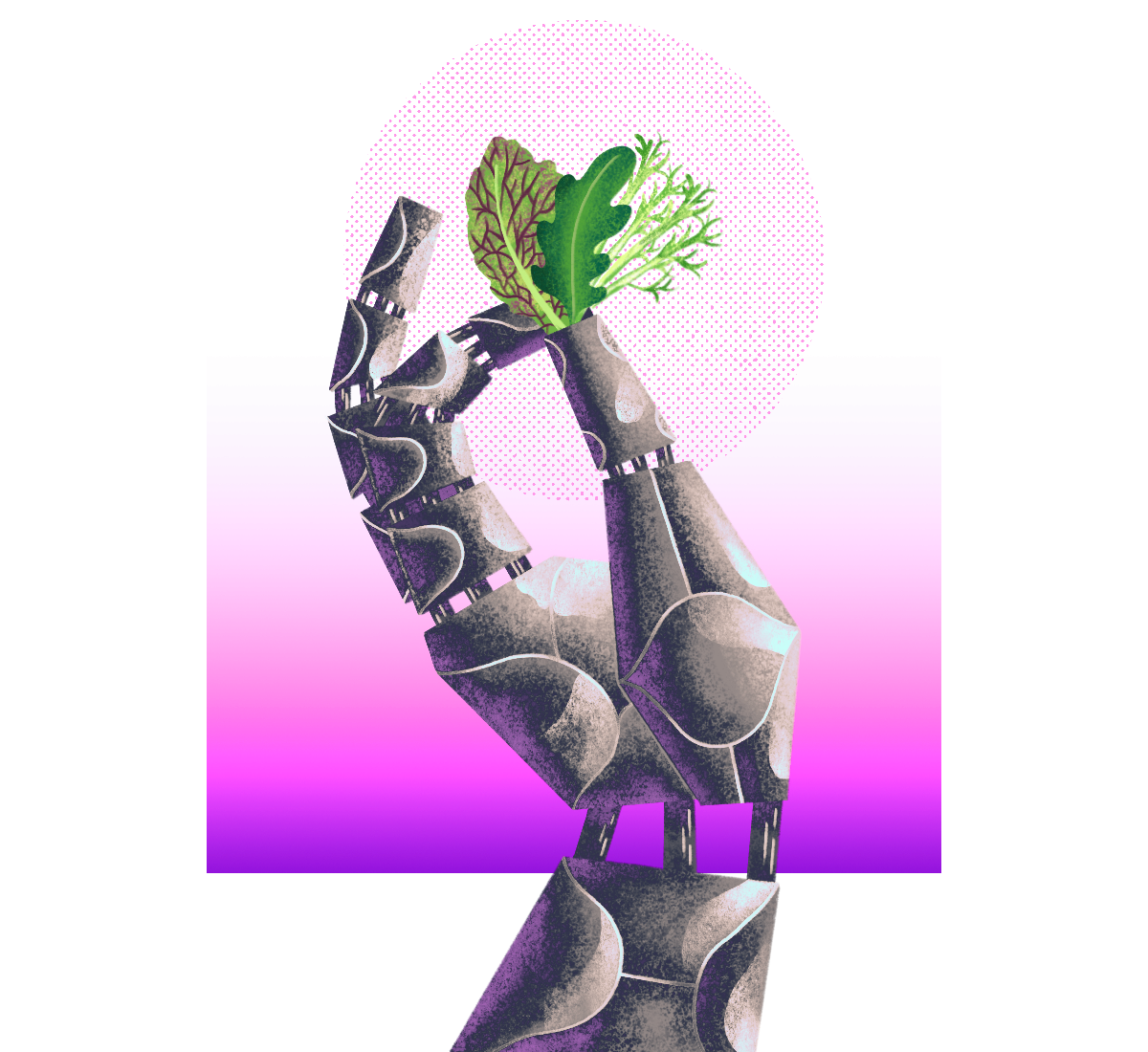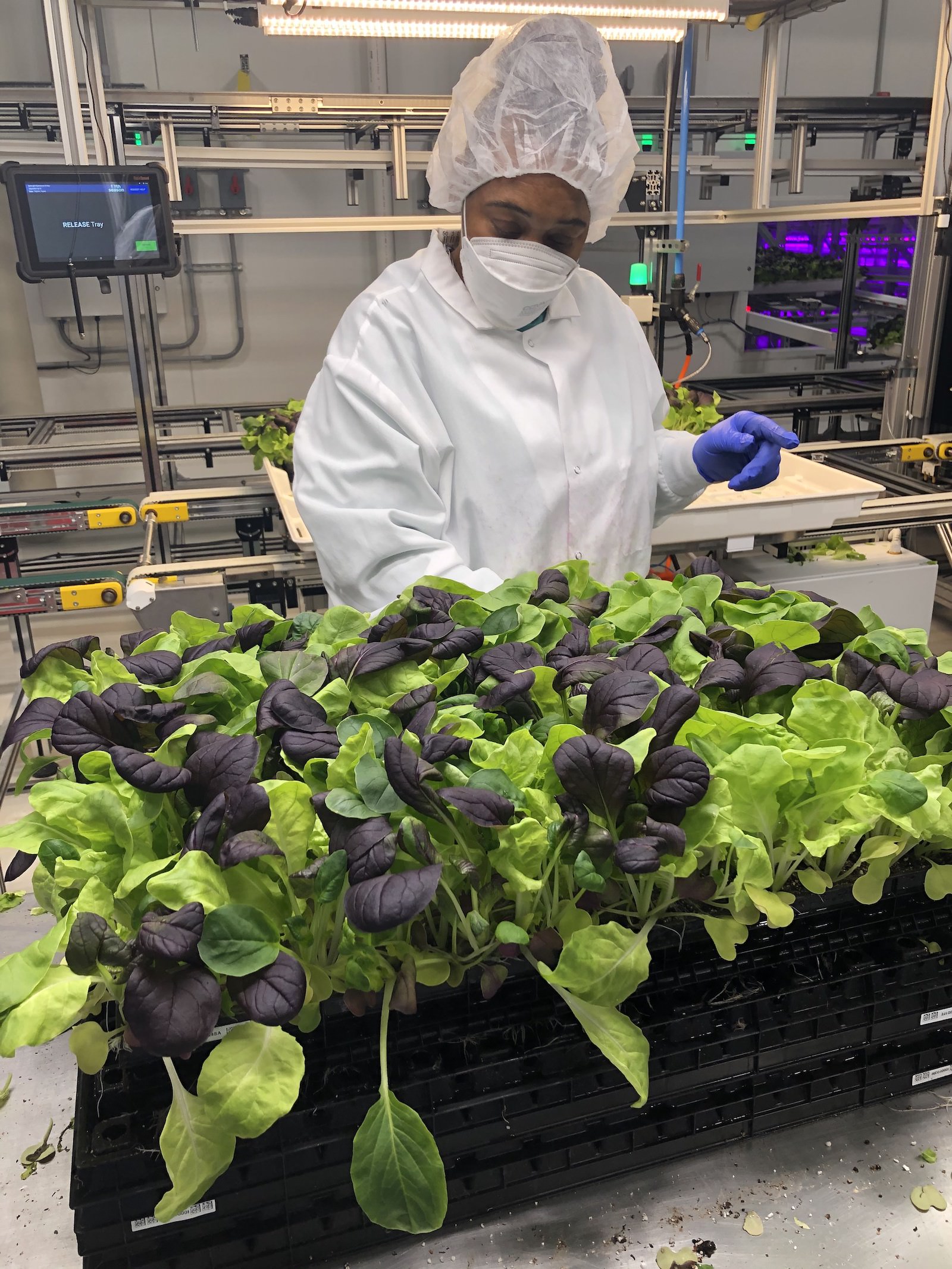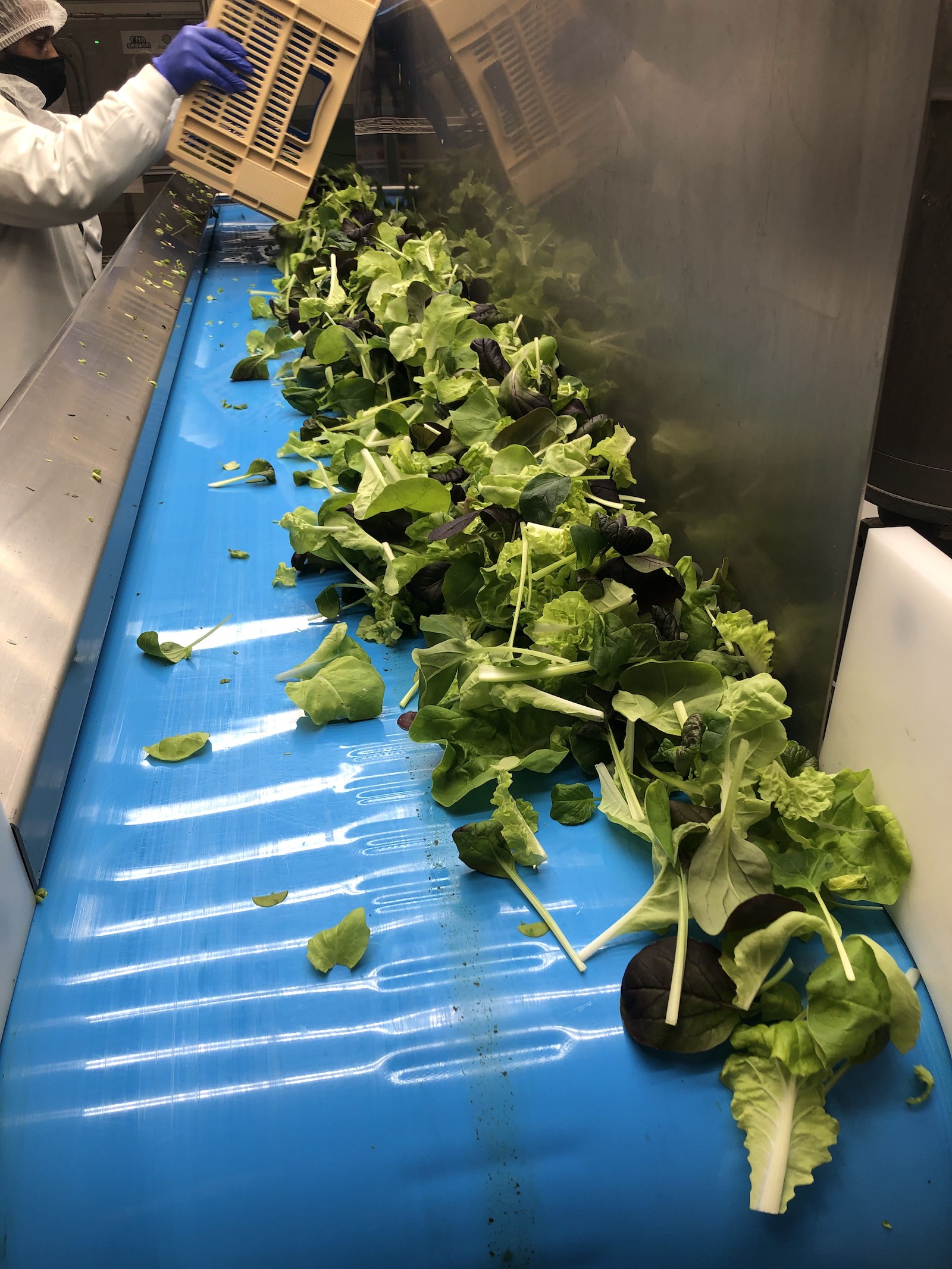Braddock, Pennsylvania is not what most people would call a farm town. White plumes of methanol, ammonia, zinc, and manganese billow throughout the day from its last remaining steel mill, while cars and pickups and freight trucks roar back and forth across the nearby Rankin Bridge. Despite its diminutive size, the town is well-known in the Pittsburgh region for its air quality, which ranks among the worst in the nation for year-round dust, soot, and smoke pollution.
And yet, inside a wide, windowless warehouse set just a block or two back from the banks of the Monongahela River, thousands of tender, young plants are thriving beneath a gleaming roof and complex HVAC system that shields them from both the azure sky and the effluence of the adjacent smokestacks.

The company Fifth Season is responsible for tending to this farm, though the startup’s use of “farm” certainly stretches traditional definitions. The greens here do not grow out of the comforting foundation of earth; they are produced “vertically,” cradled in plastic trays of soil about 16 square feet, stacked and slotted into a white tower as tall as several men, like cookies in a bakery for giants.
The indoor plots are bathed in fuchsia light and tickled by an artificial breeze, precisely calibrated by hundreds of intermittently humming fans. It is not the whim of clouds and air pressure that determines when these greens are watered; rather, it is a continuously refined algorithm that drives the robot dispersing carefully measured droplets over arrays of seedlings. Meanwhile, the human overseeing that algorithm sits in a room several states away in Michigan.
What plants does one grow in such a place? Young spinach, juvenile arugula, prepubescent brassicas — you may know them as “baby greens.” In just a few decades, they have become the standard base of any salad, commonplace in both families’ crisper drawers and the coolers of airport cafes. In order to maintain their omnipresence, more growers are looking into moving delicate crops like these indoors.
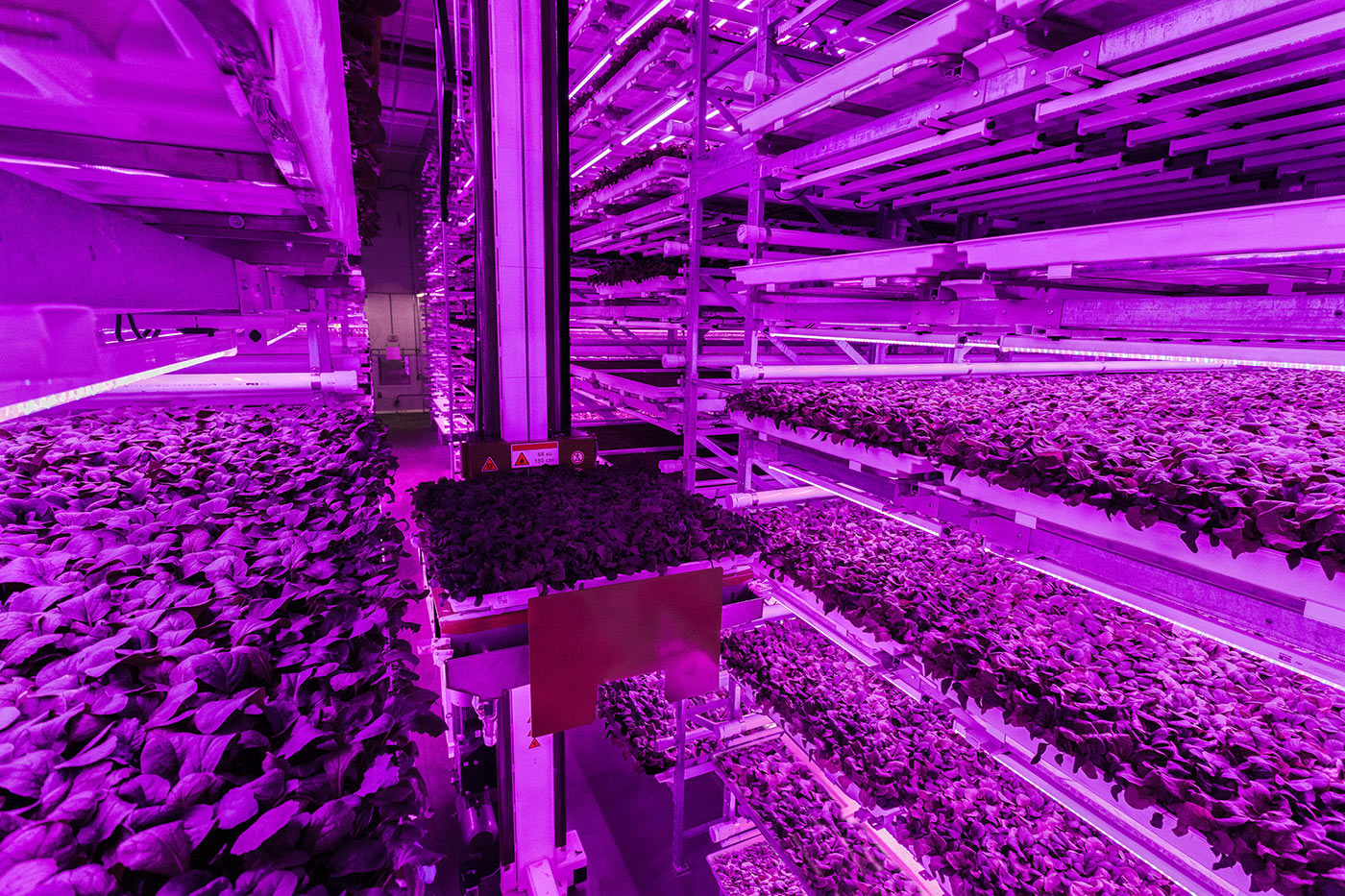
To actually incorporate these greens year-round into diets in places like western Pennsylvania, “some level of indoor production in those climates and locations will be necessary,” said Daniel Blaustein-Rejto, director of Food and Agriculture at the Breakthrough Institute, an environmental research organization in Oakland, California.
The indoor growing strategy has environmentalists split. On the one hand, anything that helps shift diets away from carbon-intensive animal products and toward plants is generally considered to be necessary to mitigate warming, including by the experts that make up the United Nations Intergovernmental Panel on Climate Change. But there are challenges to growing enough fresh produce to feed billions. Defying seasons — and, increasingly, extreme weather patterns — takes a lot of energy from an electrical grid that continues to rely heavily on fossil fuels.
But if the weather is too unpredictable and vertical farms are too energy-intensive, what’s the best way to grow greens so that anyone can eat them at any time? Or in other words: How can we democratize salad?

Salad has been around in one form or another since the days of the Roman Empire. But if a colorful forkful of spring mix has crossed your lips anytime during the past several decades, you arguably have Alice Waters to thank for it. Waters is the founder of the storied Berkeley, California, restaurant Chez Panisse, the original farm-to-table fine dining establishment. She boils her legacy down to one achievement: putting salad — true, crisp, flavorful salad — back on the American plate.
Fresh lettuce first began to appear year-round on dinner plates back in the roaring ’20s with the popularization of iceberg lettuce — what food scientist and historian Gabriella M. Petrick describes as the “first seasonless fresh vegetable.” Hardier and more resilient to transport compared to other varieties, iceberg could be grown in farms in California and Arizona and sold in big cities on the East Coast. Between 1919 and the mid-1950s, national consumption of fresh lettuce — predominantly iceberg — grew more than threefold. As refrigeration and freight technology continued to improve, other forms of produce began following a similar supply route, allowing for the proliferation of larger, more specialized grow operations.
But Waters’ vision of American salad went beyond a wedge of iceberg lettuce slathered in a cream-based dressing. Her virescent awakening occurred in the 1960s while she was visiting a friend in France. In the countryside on the outskirts of Nice, Waters ate her first mesclun salad, a dish which takes its name from the Provençal word for mixture. “The farmers just went around the field and picked things,” Waters said. “And they put it all in a big dish towel and brought them to the farmers market, and you bought it by the pound.” Sometimes the mix would have dandelion greens and rocket and chervil, and sometimes a little oak leaf lettuce, red and green, but it was always a blend of local offerings picked in their prime. Waters’ friend would dress it simply with anchovy and garlic. “I just loved it,” she recalled.
According to Waters, the beauty of the mesclun salad, as the farmers did it in France, was that each meal was unreproducible. You might never come across the same combination of leaves twice. And that was exactly what Waters sought to recreate when she brought the dish to the menu at her restaurant. The fresh greens that Chez Panisse serves to customers grow right on the grounds of the establishment itself in a large garden, picked by hand for each plate. Waters is so committed to her salad’s vision — a combination of balance, freshness, and flavor — that when she was asked in 1980 to serve her version of a garden salad at a Playboy magazine award dinner in New York City, she flew from California with her own flats of still-growing rocket lettuce and nasturtium blossoms in order to harvest them right there at the event.
“I want what is of that moment, I want to be reminded of nature,” she said. “That’s what mesclun gave me — that sense of biodiversity.”
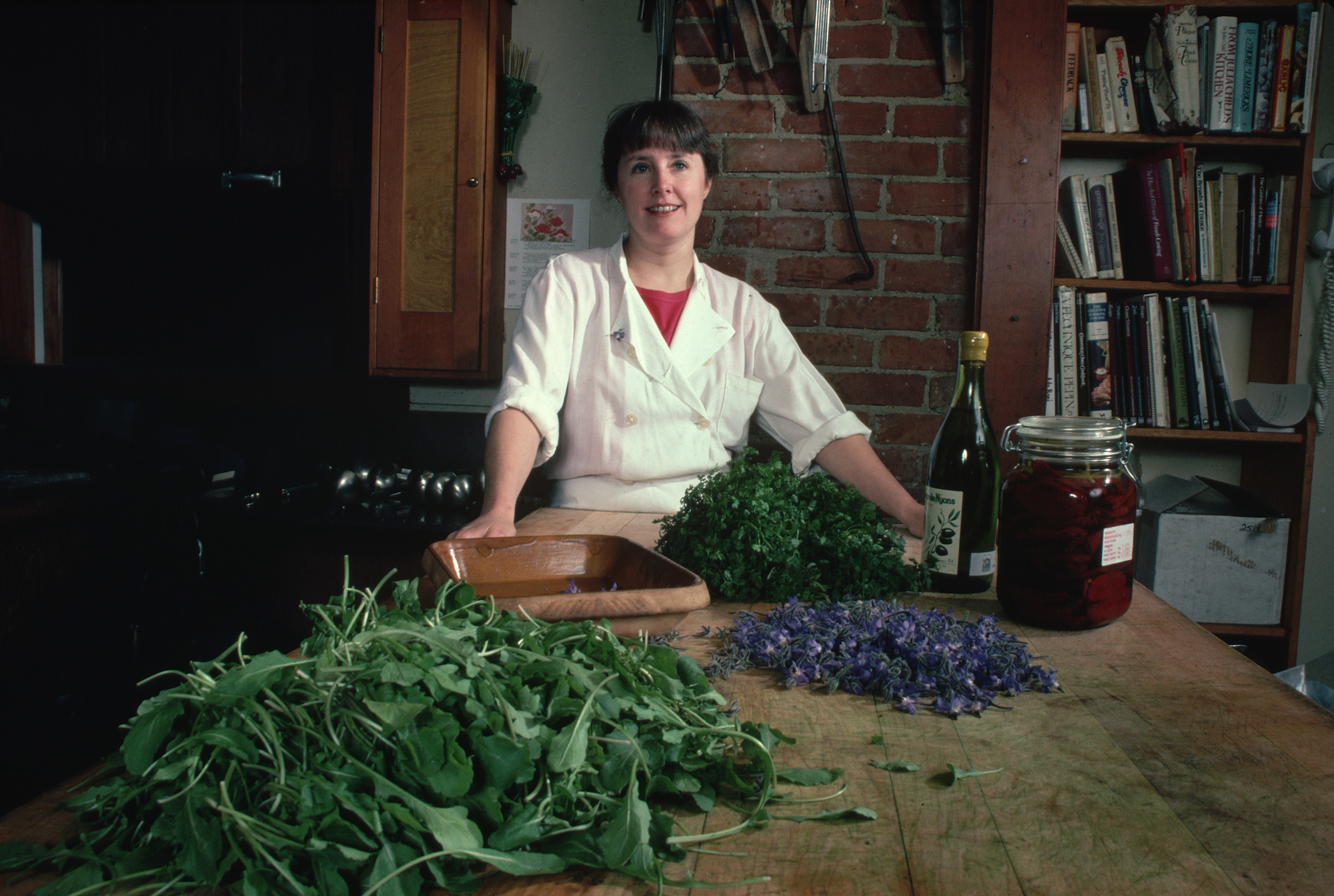
Biodiversity is a popular refrain among a high echelon of farm-to-table chefs, including Waters and Dan Barber, the celebrated chef and owner of New York’s Blue Hill at Stone Barns. They argue that we have bruised the Earth with abrasive monoculture, that a climate-friendly diet is not so much about what you eat as how you grow it. If you are of this school of thought, mass-produced salad — be it grown on an industrialized single-crop farm in California or by robots in a warehouse in Western Pennsylvania — is a perversion of the natural order.
In his popular 2006 treatise on the food industry, The Omnivore’s Dilemma, science writer Michael Pollan described his own grappling with the massive scale, industrial precision, and calculated sterility that goes into each package of tender, perfectly-sized lettuces. Following a visit to the facilities of Earthbound Farms, then the largest organic salad producer in the country, he noted his newly wilted preconceptions: “The contrast of the simplicity of this type of eating, with all its pastoral overtones, and the complexity of the industrial process behind it produced a certain cognitive dissonance in my refrigerated mind,” he wrote. “In precisely what sense can that box of salad on sale in a Whole Foods three thousand miles and five days away from this place truly be said to be organic?”
Waters remembers being similarly affected by her first encounter with a grocery store bag of Dole “mesclun” mix. She found it depressing. “I just thought: This is not what it was about, at all,” she told Grist. “They were co-opting a really beautiful idea, and not giving it its due — not giving it its reason for being.”
Waters is not bemoaning the fact that salad can be purchased in grocery stores; she says she wants everyone, everywhere to eat more salad. It’s more the fact that an industrially produced mesclun mix is an oxymoron, by her definition. For one thing, prepackaged salad’s “freshness” is debatable: To keep the greens looking good on store shelves, baby greens are packed along with a mixture of gases — a “modified” or “protected” environment in industry lingo — that can prevent them from wilting for a week or more. But the more time passes from harvest to consumption, the less the nutritive value of the leaves. Still, Pollan, a regular at Waters’ restaurant before the pandemic, acknowledges that industrial-style production is necessary to achieve a widespread adoption of his well-known dictum: “Eat food. Not too much. Mostly plants.” Very few people have the time or money to forage their way through the French Baronnies or Berkeley backyards to enjoy a bowl of delicate, seasonal leaves.
Navin Ramankutty, a professor at the Institute for Resources, Environment, and Sustainability at the University of British Columbia, says that it’s important to find a balance between nutritive value and widespread access. He explains that even as fewer people in the world go hungry, nutrient deficiencies remain high — the current global estimate is that 2 billion people suffer from at least one form — and the best remedy is to feed people more fresh fruits and vegetables. Canada, for example, just published national dietary guidelines that recommend filling half your plate with fresh fruits and vegetables. And yet, a study from Emory University found that the world does not currently grow enough fresh fruits and vegetables to meet dietary guidelines even less ambitious than Canada’s.
Fresh salad — particularly of the true mesclun variety — has certainly become available beyond the menus of white-cloth restaurants, but it’s still a relatively pricey grocery item. For the outdoor-farmed lettuce varieties, that’s been partially due to climate change-driven events, like early spring weather throwing off planting schedules in recent years and heat waves singeing harvests; for plants grown indoors, the expense is due to the higher costs entailed by a still emerging, boutique industry. And yet, salad remains an in-demand item, particularly the baby greens-laden prepackaged mixes that command higher prices in exchange for convenience.

But for all its value in micronutrients, a bag of arugula does not offer much in the way of calories, which is more important to a hungry person with limited funds. A U.S. Department of Agriculture analysis found that only 20 percent of Americans eat salad on a given day, and that statistic drops to 15 percent for the lowest income bracket.
Assuming you can afford them, it’s easy to understand how baby greens became the darlings of the salad set. If you buy a full head of, say, butter lettuce, you cannot simply chomp on it like you would an apple. If you want to make a salad like a normal person you will have to slice the lettuce into smaller, bite-sized pieces. But as soon as the knife makes contact with the leaf, an enzymatic reaction — akin to that of skin healing from a wound — will discolor its cut edges, causing the leaf to start to brown, wilt, and rot.
Each leaf of baby greens, on the other hand, is ideally sized to fit in a human mouth, no mutilation necessary. And furthermore, they don’t even need to be washed. Prepackaged salad mix is designed to be poured directly from its plastic container into a bowl, or even — gasp! — eaten straight from the container itself with some bottled dressing.
“One thing that is clear is that over time, the needs of the consumer for something that is ready to eat, quick to eat, and healthy is really driving the vegetable industry toward fresh-cut produce,” explained Francesco Di Gioia, a professor in the department of plant science at Penn State University. “And the baby leaf was developed to serve the needs of the fresh-cut industry and ready-to-eat salads.”

Today, the majority of U.S. lettuce is still grown outdoors in a few select areas of the country — California’s Imperial Valley or the salad bowl of Yuma, Arizona — then processed and shipped sometimes thousands of miles until it reaches the produce aisle of a grocery store. But as drought and precipitation cycles in the West have become both more extreme and temperamental, it’s simply not sound climate policy to rely on California for so much of the nation’s greens. Extreme weather patterns weaken leaf integrity, making the plants more susceptible to contamination and disease. Flood and wind events can easily spread dust from nearby animal feedlots onto fields and into reservoirs. Leafy greens can’t easily be sterilized, which is one reason they are the culprits behind so many E. coli outbreaks.
If Americans want to eat more salad — and going by industry predictions, they do — the supply chain that brings the leaves from the earth to the plate (or the plastic clamshell, as the case may be) has to be both reliable and efficient. According to Di Gioia, farming is no longer a simple business. “It’s more technological, more advanced,” he explained. “You need people there who know what they’re doing, people who are in charge of production, an agronomist, people who are going to check that everything is safe and high quality.”
That could not be more apparent than at the robot-operated Fifth Season. Only a few sanctioned humans are allowed to wander the aisles of the biodome, given a security clearance and exhaustive sanitation ritual that has little to do with workers’ COVID risk, but is meant to protect delicate plants from any number of foreign microbes. Most of the movement in this sterile, cavernous warehouse occurs as a couple of crane-like machines glide up and down the aisles. They pull one little slat of greens from its slot and move it into another, perhaps several times over the course of one day, to perfectly optimize its growing conditions: a little more light, a little less breeze, just this quantity of nutrient-enhanced water.
Fifth Season started in 2015 as a robotics company, trying to sell its products to other greenhouse growers. At the time, they found prospective buyers few and far between, so they decided to go into vertical farming themselves using their own robots. During my tour of their Braddock greenhouse, I saw seeding robots, watering robots, and fanning robots — the fanning helps ensure each baby spinach leaf has the right amount of crunch, explained my tour guide and Fifth Season’s chief category officer, Grant Vandenbussche. Robots also indicate when the plants are ready to be harvested.
When that moment arrives three to five weeks later — the exact timing determined, again, by the algorithm — an entire tray is pulled from its shelf in the biodome and delivered along a conveyor belt into a new, only slightly less regimented room. A woman with only a sliver of face visible through protective equipment gently prods and examines each leaf with a pair of large tweezers, checking various characteristics against a checklist on a gleaming iPad, before the whole container slides on to be harvested. In one swift, clean slice, hundreds of leaves are cut from their stems and shuttled off to their next destination.
A worker at Fifth Season checks on trays of still-growing baby greens, left. Workers wear protective gear to prevent the delicate lettuces from outside contamination. On the right, a conveyer belt at Fifth Season moves freshly harvested baby greens for processing. Photos by Eve Andrews / Grist.
When this tray, so very precisely planted and fertilized and watered and photosynthesized over the past 20 days or so, emerges from the harvesting machine, it is a chartreuse-and-emerald buzz cut. It has been reduced to hundreds of slim inch-high stalks, packed so densely that you can barely see the soil between them. But this shorn garden barely has a moment to realize its own nakedness before it is unceremoniously emptied from its cream plastic tray into the compost bin, the tray sent on to be replanted and the process begun anew.
There is not a puff of air or drop of water that is not automated in the greens-growing process of this warehouse — a level of standardization Vandenbussche says holds a growing appeal, particularly in contrast with harvests that are more exposed to the increasingly vacillating elements.
But Fifth Season’s level of control comes at a cost. It turns out when you recreate the Salinas Valley under a roof, it requires a lot of electricity. Crops need light, water, and soil to grow. On a traditional farm, you might have to pipe in the water and meticulously fertilize and pH-balance the soil, but all that abundant California sun comes free.
“We’re talking about substituting that energy indoors,” Ramankutty said. “And that energy cost is too high for anything other than niche crops.”

If your vertical farm is located in a region that depends largely on fossil fuels for its energy — like, say, western Pennsylvania — the carbon footprint of your indoor-grown salad is likely going to exceed that of the one from the farm. That calculation might change as those grids shift to renewable power sources and indoor growing technology becomes more energy efficient. Having more indoor operations located near large East Coast markets could cut down on emissions related to transportation, which usually constitutes the largest portion of lettuce’s carbon footprint. But for most crops, greenhouse growers have a long way to go before those benefits outweigh the energy that goes into heating, cooling, and lighting an indoor farm.
Energy expenditures notwithstanding, the profit-minded case for indoor farming is already compelling enough for some growers to scale up. When Paul Lightfoot founded the mid-Atlantic salad grower BrightFarms in 2010, it was based on what he describes as a sort of well-informed business hunch. Today, BrightFarms grows 6.5 million pounds of baby greens per year in large greenhouses. The company harvests and packages them on-site, and distributes them within 200-ish miles of each farm, covering a swath roughly from Wisconsin to Delaware.
“I knew it wasn’t that old of an industry, it was growing quickly, and it would keep growing,” Lightfoot said. “People would eat more salads and make a better connection between what they’re eating and their health. What I wouldn’t have predicted is that it’s still a fast-growing category, but most growth is coming from indoor salad producers.”

Baby greens are a particularly tricky crop to scale without making a few compromises. Precise timing is required to harvest a young leaf at its proper size, flavor, and freshness. They have to be protected from pests, sun, frost, and dust. And while no one needs to eat salad, people are drawn to baby greens for their combination of flavor, healthfulness, and convenience. Advocates of indoor growing say it’s an ideal crop to experiment with, as the growing time is relatively short compared to staples like grain or wheat — which, right now, would be incredibly inefficient candidates for indoor agriculture.
There may, however, be some real environmental benefits to embracing some “unnatural” grow operations in the long term. For all its chilly sterility, the land and water footprints of indoor farms are a small fraction of that of traditional farms. And when you grow everything under one climate-controlled roof within a day’s drive of the grocery store that will be distributing it, a lot of the uncertainty of the supply chain gets eliminated — and along with it, food waste.
Lightfoot explained the calculus of grocery store marketing as being similar to that of a hotel, with one of those damp, refrigerated shelves in the produce section akin to a floor of rooms. You want every room filled, or you’re losing money. At the beginning of the COVID-19 pandemic, when the supply chains of big agricultural conglomerates were suddenly snapped, a lot of those shelves lay dry and empty. Producers with shorter, more reliable paths to market started to look a lot better. It’s even nicer if you can charge a little more for that sweet “local” label.
To that end, he notes that while indoor farming can, in theory, bring fresh produce to a wider market, that’s not the motivation currently driving the boom in baby greens. One reason grocery stores have doubled down on boutique salad mix is because it brings in an economically desirable demographic. “People buying our salads are model customers,” he said. “Younger, health-focused, higher level of wealth.”
Salad — really the entire food system in general — is caught up in this same climate-driven catch-22. Farmers will need to invest in new techniques and technology to keep certain foods available to consumers on demand. Food justice advocates emphasize that giving all communities access to fresh foods must be a part of that equation. But, by the laws of economics, the cheaper a crop becomes, the less incentive there is for profit- and tech-minded, growers to buy in.
“I just don’t see indoor production reducing the cost of most of these foods,” said the Breakthrough Institute’s Blaustein-Rejto. “They seem to be a niche item that is appealing to some people who want to buy food hyperlocally. But I don’t think that kind of production, at least in the foreseeable future, will cut costs and help make these foods more affordable or accessible.”
If you walk about two blocks up from the Fifth Season facility, away from the river but still within a touchdown pass of the steel mill, you’ll find yourself at Braddock Farms. On a little less than an acre, a small farm staff raises all forms of produce under the mill’s toxic clouds. The farm, run by the nonprofit Grow Pittsburgh, opened in 2007, at the request of the then-mayor, John Fetterman, now Pennsylvania’s lieutenant governor and a 2022 Democratic candidate for U.S. Senate.
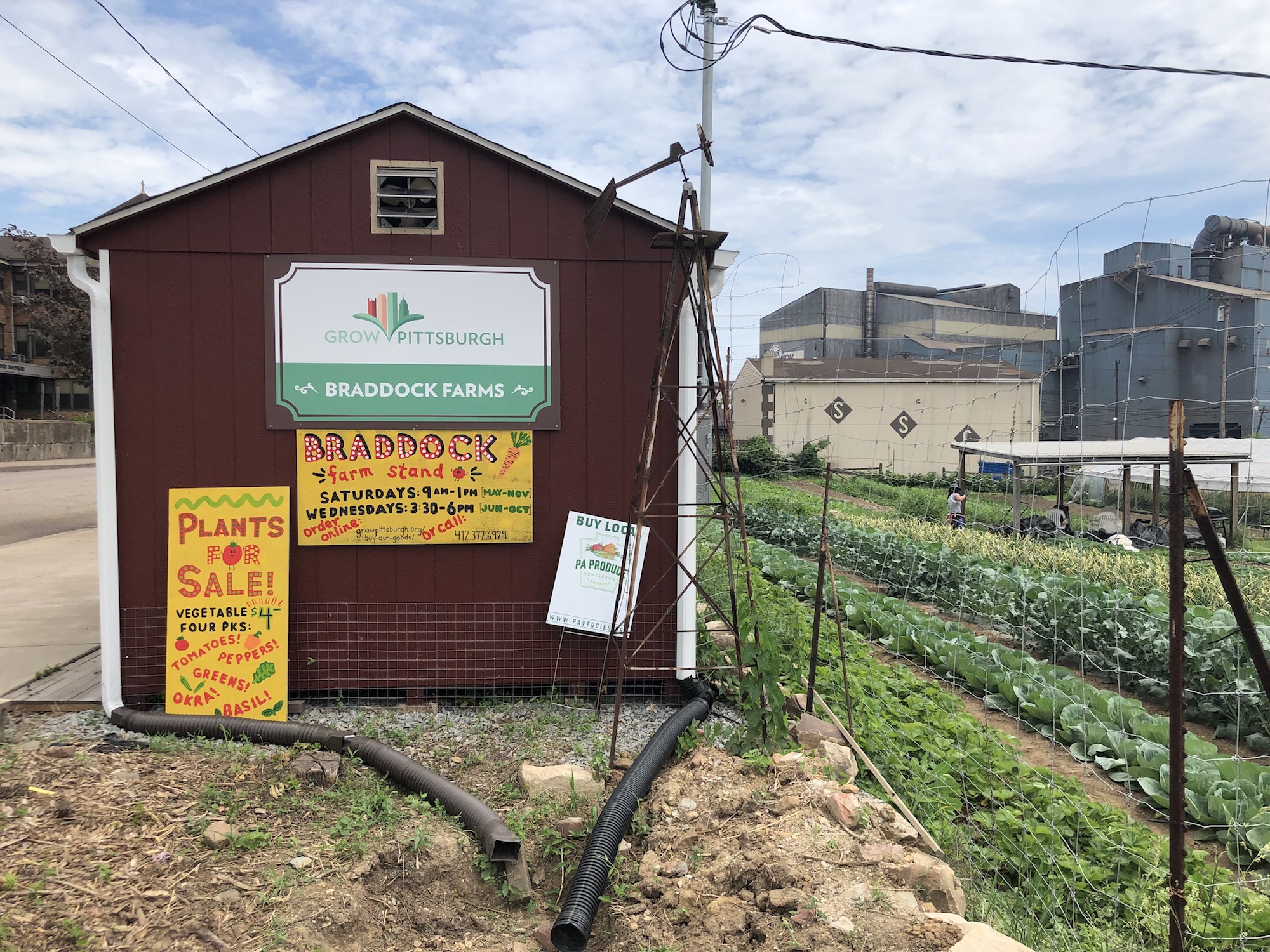
Fetterman wanted Braddock to have access to local produce. At the time the farm was founded, the town did not have a grocery store. The organization now sells its wares in four different farmers markets located in predominantly Black and lower-income neighborhoods. Its salad greens, notes farm manager Nick Lubecki, are very popular and are priced to be competitive with conventionally grown options sold at the grocery chains Giant Eagle and Aldi, the latter of which opened in Braddock earlier this year.
On an oppressively steamy June afternoon, Lubecki showed around me the small farm. Zucchini plants bloomed under tent-like hoop houses, lines of onion stalks drooped a bit in the heat; and rows of mauve, violet, and pale green heads of lettuce erupted from plastic mulch, many of the heads heftier than a human newborn. Most baby leaf greens are too finicky to grow here because of their sensitivity to weeds and pests, but Lubeki pointed to a cluster of arugula sprouting under a protective cloth cover. The salad mix they sell comes instead from the Salanova breed of lettuce, he explained, lifting up the lowest skirt of a curly-leafed specimen to show its rooted core. It grows as a head, but you can cut it from the bottom and all the leaves will fall separately into a neat heap, creating the coveted single-bite-size product.
The small farm has doubled in size since its start, pushed by demand for its locally grown crops, but the obvious challenges remain. Grow Pittsburgh tests the farm’s soil regularly for heavy metals and other pollutants that might rain down on it from the nearby steel mill. According to Lubecki, the levels currently meet the safety standards required by the state. But the local air pollution, trapped in the valley by the heat, especially on the increasingly sweltering days during the growing season — “last summer was brutal, and this one is shaping up to be” — is the operation’s real challenge; not for the plants so much, but on the people who work at the farm and pick them.
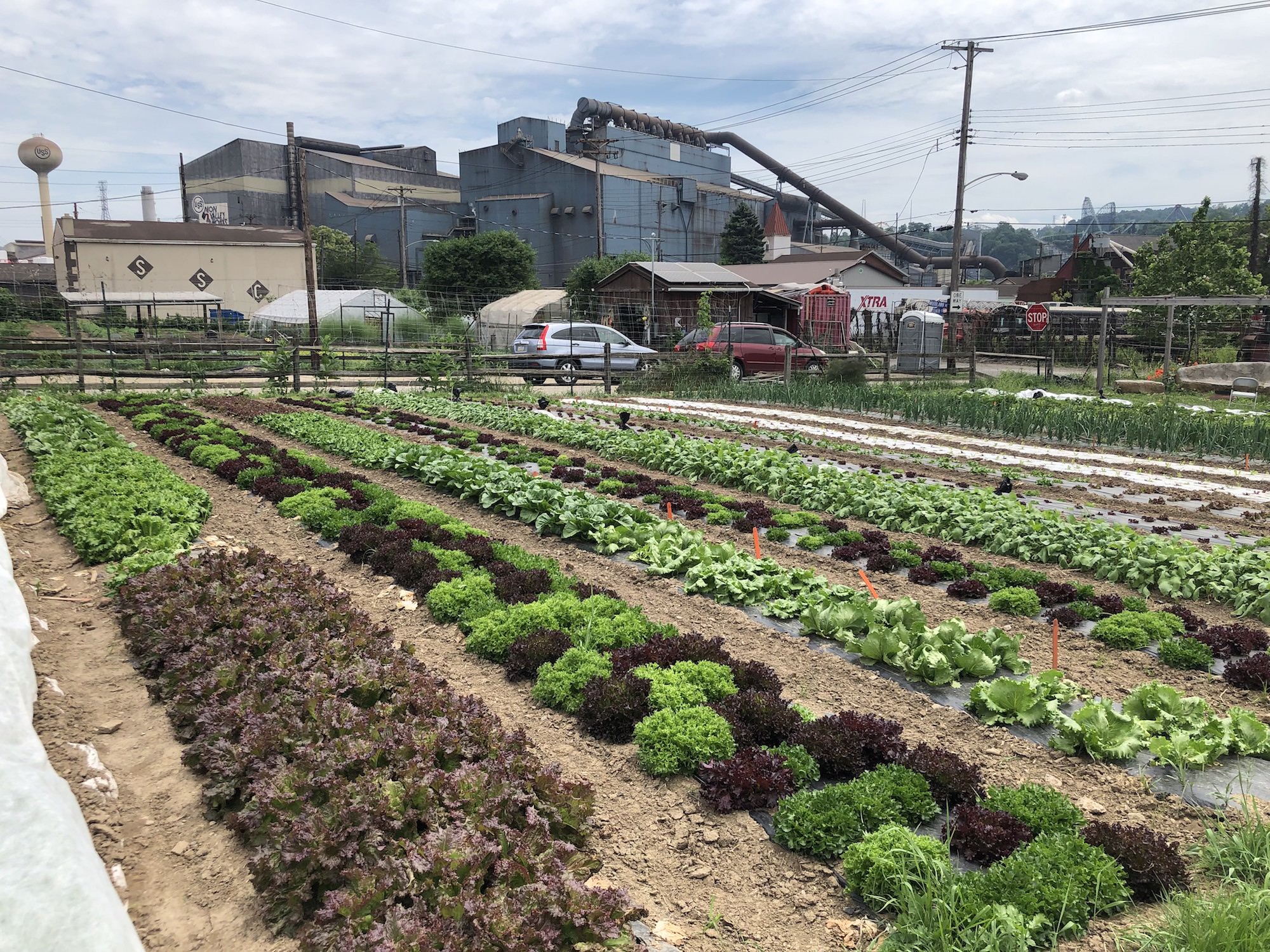
When asked if this same farm could be profitable were it not subsidized by Grow Pittsburgh, Lubecki was confident that it would — though it would likely require a different labor structure and a new assortment of crops. What assortment of crops, then? More salad, because people will actually pay its true cost.
“People like salad,” he said. “They get mad if you charge $5 for an onion, but they’ll pay close to that for a head of lettuce.”

